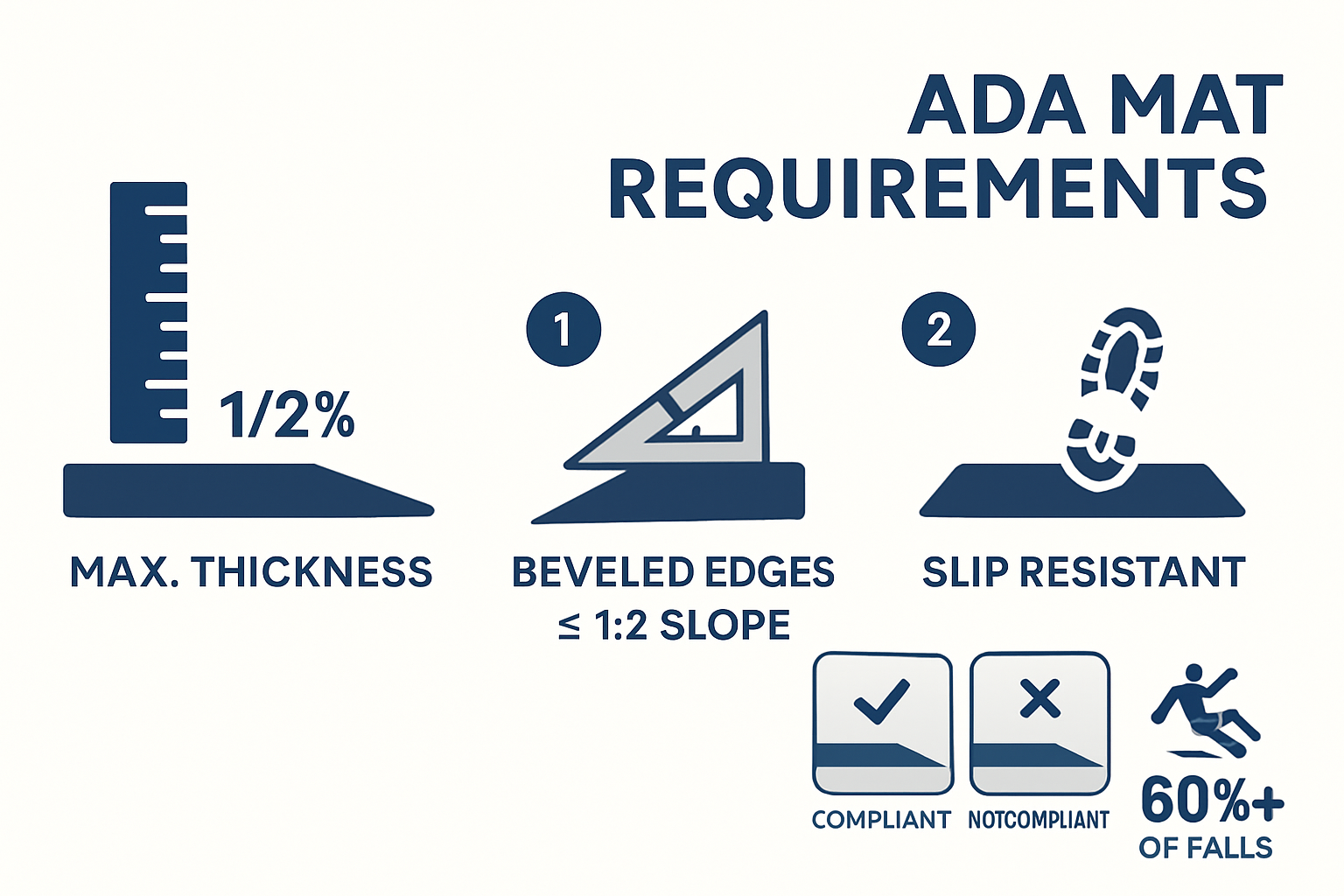ADA compliance for floor mats might seem like a minor detail, yet up to 40 percent of facility-related accessibility lawsuits involve floor surfaces. Surprised to hear something as simple as a mat could spark legal trouble and impact safety for everyone walking through your doors? The real shock is how the right mat choice and placement can not only prevent costly liabilities but also turn any entryway into a safer, more welcoming space for all.
Table of Contents
- Understanding Ada Compliance For Floor Mats
- Key Features Of Ada Compliant Floor Mats
- Best Practices For Selecting And Placing Mats
- Benefits For Businesses And Facility Managers
Quick Summary
| Takeaway | Explanation |
|---|---|
| Ensure ADA Compliance for Mats | Use mats that meet ADA standards to prevent legal issues and enhance accessibility for users. |
| Select Proper Mat Features | Choose mats with the right thickness and beveled edges to reduce tripping hazards and ensure safe transitions. |
| Strategic Placement is Key | Position mats thoughtfully to enhance wheelchair navigation and minimize accidents in high-traffic areas. |
| Prioritize Material Performance | Select durable materials that hold shape and provide a stable surface under regular use for greater safety. |
| Enjoy Economic and Safety Benefits | Implementing compliant mats can lower injury costs and boost facility reputation by improving safety conditions. |
Understanding ADA Compliance for Floor Mats
Accessibility is not just a legal requirement but a fundamental commitment to creating inclusive environments for all individuals. The Americans with Disabilities Act (ADA) sets critical standards that guide facility managers and businesses in designing spaces that accommodate people with diverse mobility needs.
The Legal Framework of ADA Accessibility
The ADA establishes precise guidelines for floor surface conditions to ensure safe navigation for individuals with mobility challenges. Research from the National Disability Rights Network reveals that floor mats play a crucial role in meeting these accessibility requirements. The regulations specify critical parameters such as mat thickness, edge beveling, and surface smoothness to prevent tripping hazards and facilitate wheelchair movement.
Below is a summary table outlining the key ADA compliance requirements for floor mats as discussed in the article. This table helps facility managers quickly reference the standards that must be met for legal and practical accessibility.
| ADA Requirement | Specification/Detail |
|---|---|
| Surface Transition | Mats must provide smooth transitions between surfaces |
| Thickness Limitations | Maximum thickness of 1/2 inch for wheelchair accessibility |
| Edge Specifications | Beveled or rounded edges to prevent tripping hazards |
| Surface Texture | Slip-resistant material for stability |
Key ADA compliance requirements for floor mats include:

- Surface Transition: Mats must create smooth transitions between different floor surfaces
- Thickness Limitations: Maximum mat thickness of 1/2 inch for areas requiring wheelchair accessibility
- Edge Specifications: Mats must have beveled or rounded edges to prevent potential tripping
Practical Implications for Facility Management
A peer-reviewed study on accessibility highlights the critical connection between proper floor mat placement and reducing fall risks for individuals with disabilities. Facility managers must carefully consider mat selection to ensure both safety and legal compliance. This involves evaluating mat materials, edge design, and installation techniques that support seamless movement for all users.
Beyond legal compliance, implementing ADA-compliant floor mats demonstrates a commitment to universal design principles. These mats not only protect individuals with mobility challenges but also create a more welcoming environment for everyone. Learn more about accessible mat solutions that meet rigorous safety standards.
Understanding ADA compliance is more than checking boxes. It represents a proactive approach to creating spaces that respect and support the diverse needs of all individuals. By investing in properly designed floor mats, businesses and facilities can ensure safety, accessibility, and inclusivity for every visitor and employee.
Key Features of ADA Compliant Floor Mats
ADA compliant floor mats are engineered with specific design characteristics that go beyond aesthetic considerations. These specialized mats are critical components in creating accessible environments that support mobility, safety, and independence for all individuals.
Dimensional and Surface Requirements
The U.S. Access Board’s guidelines establish precise specifications for floor mat dimensions and surface properties. Mat thickness is a critical factor, with regulations specifying a maximum height of 1/2 inch to ensure smooth transitions for wheelchair users. This seemingly small detail has significant implications for mobility and user safety.
Key dimensional specifications include:
- Thickness Control: Maximum 1/2 inch height to prevent tripping hazards
- Edge Design: Beveled or rounded edges for seamless floor integration
- Surface Texture: Slip-resistant materials that maintain stability
Material and Performance Considerations
The 2010 ADA Standards for Accessible Design emphasize the importance of mat materials that provide stable and firm surfaces. Compliant mats must demonstrate exceptional performance characteristics, including:
- Resistance to compression and deformation
- Ability to maintain structural integrity under repeated use
- Consistent surface evenness across the entire mat area
Materials like low-pile rubber, specialized synthetic fabrics, and engineered composites are often used to meet these rigorous standards. Explore our advanced mat solutions that deliver both compliance and performance.
Beyond technical specifications, ADA compliant floor mats represent a commitment to universal design. They transform spaces from merely functional to genuinely inclusive, ensuring that every individual can navigate environments with dignity, safety, and confidence. By prioritizing these specialized mat features, facilities demonstrate a proactive approach to accessibility that goes far beyond legal minimum requirements.
Best Practices for Selecting and Placing Mats
Selecting and placing ADA-compliant floor mats requires strategic planning and careful consideration. Facility managers must approach mat selection as a critical component of creating accessible, safe, and welcoming environments for all individuals.

Comprehensive Mat Selection Criteria
The U.S. Access Board’s guidelines provide essential insights into mat selection. Choosing the right mat involves evaluating multiple factors beyond mere aesthetic appeal. Critical considerations include material durability, surface texture, edge design, and overall performance in high-traffic areas.
Key selection criteria encompass:
- Material Resilience: Choose materials that maintain structural integrity under constant use
- Surface Compatibility: Ensure mat works seamlessly with existing floor surfaces
- Thickness Management: Select low-profile mats that meet ADA thickness requirements
Strategic Placement and Installation Techniques
The Illinois Capital Development Board ADA Standards emphasize the importance of precise mat placement. Proper installation is as crucial as mat selection. Facility managers must consider wheelchair accessibility, potential tripping hazards, and overall space navigation when positioning mats.
Critical placement considerations include:
- Maintaining clear floor space for wheelchair maneuverability
- Avoiding mat edges that create unexpected level changes
- Securing mats to prevent curling or displacement
Regular maintenance is equally important. Mats should be inspected frequently for wear, displacement, or potential safety hazards. Explore our comprehensive mat solutions designed to meet the most rigorous accessibility standards.
Beyond technical specifications, effective mat selection and placement represent a commitment to inclusive design. Each carefully chosen and positioned mat contributes to creating environments that welcome and support individuals of all mobility levels. By prioritizing accessibility, facilities demonstrate a profound respect for diverse user needs and a commitment to creating spaces that are truly accessible to everyone.
Benefits for Businesses and Facility Managers
ADA compliant floor mats represent more than a legal requirement. They are strategic investments that deliver multifaceted benefits for businesses, facility managers, and the diverse individuals who navigate these spaces. Understanding these advantages goes beyond mere regulatory compliance.
Risk Mitigation and Safety Enhancement
The Occupational Safety and Health Administration (OSHA) emphasizes that appropriate floor matting significantly reduces workplace accidents. By implementing ADA-compliant mats, businesses can dramatically minimize slip, trip, and fall incidents, which are among the most common workplace injuries.
Key safety benefits include:
- Accident Reduction: Lowering potential liability from workplace injuries
- Predictable Surface Transitions: Creating consistent floor surfaces that prevent unexpected level changes
- Improved Traction: Providing stable walking surfaces in high-traffic areas
Economic and Operational Advantages
Beyond safety, ADA-compliant floor mats offer substantial operational benefits. A workplace safety study revealed that businesses can save significant costs by proactively addressing potential hazards. These mats not only protect employees and visitors but also demonstrate a commitment to inclusive design.
Operational benefits encompass:
The following table organizes the operational and safety benefits of ADA compliant floor mats, helping businesses and facility managers clearly understand the value these mats bring beyond just compliance.
| Benefit Category | Description |
|---|---|
| Accident Reduction | Lowers potential liability from workplace injuries |
| Improved Traction | Provides stable walking surfaces in high-traffic areas |
| Predictable Transitions | Ensures consistent, level floor surfaces for smooth navigation |
| Reduced Claims | Decreases worker compensation and injury claim costs |
| Enhanced Reputation | Demonstrates commitment to safety and accessibility |
| Lower Maintenance | Helps reduce facility cleaning and upkeep expenses |
- Reduced worker compensation claims
- Enhanced facility professional reputation
- Decreased maintenance and cleaning costs
- Improved overall workplace ergonomics
Learn more about our specialized mat solutions designed to meet both safety and accessibility standards.
The strategic implementation of ADA-compliant floor mats transcends basic regulatory compliance. These mats represent a holistic approach to facility management that prioritizes safety, accessibility, and operational efficiency. By investing in high-quality, thoughtfully designed mats, businesses create environments that welcome everyone, reduce potential risks, and demonstrate a genuine commitment to inclusivity and professional responsibility.
Frequently Asked Questions
What are ADA compliant floor mats?
ADA compliant floor mats are mats designed to meet the Americans with Disabilities Act (ADA) standards, ensuring accessibility and safety for individuals with mobility challenges. They are characterized by features like maximum thickness limits, beveled edges, and slip-resistant surfaces.
Why is ADA compliance important for floor mats?
ADA compliance for floor mats is crucial to prevent tripping hazards and ensure safe navigation for individuals with disabilities. Non-compliance can lead to legal issues and may contribute to accidents, making it vital for facility managers to adhere to these standards.
What are key features to look for in ADA compliant mats?
Key features to consider include a maximum thickness of 1/2 inch, beveled edges to prevent tripping, slip-resistant surfaces for stability, and durable materials that maintain their structure over time. These specifications enhance the safety and accessibility of the mats.
How should I place ADA compliant floor mats in my facility?
ADA compliant mats should be strategically placed to ensure smooth transitions between different floor surfaces, allowing for easy wheelchair navigation. Ensure that mats are securely positioned and regularly checked for wear or displacement to maintain safety.
Ready to Make Your Facility Truly Accessible?
You have just learned how quickly non-compliant mats can create risks and legal troubles. Even small issues like improper thickness or poor mat placement can become serious barriers for everyone—guests, customers, and staff alike. If your goal is to enhance safety, limit your liability, and embrace best practices for inclusion, you need floor mats that truly meet ADA standards. At Mats4U, we provide durable solutions that address all the pain points highlighted in our guide, from slip-resistant surfaces to secure transitions and easy movement for wheelchairs.
Discover our wide selection of Indoor Mats designed to satisfy both regulatory requirements and real-world needs in busy commercial spaces. Find customer favorites and proven performers on our Top Rated Mats page. Take action now to safeguard your facility, protect your reputation, and create a welcoming environment for everyone with Mats4U.com.
Recommended
- Mats4EU | Logo Mats Making a Lasting Impression – Mats4U USA
- Comfort Station Max Mat – Anti-Fatigue Grease-Resistant Mat with Drainage Option – Mats4U USA
- Logo Mat Deal – Mats4U USA
- Mats4EU | Why Entrance Mats are a Must-Have for Every Business – Mats4U USA
- Exciting PDF Accessibility Guidelines for Business Empowerment
- 2025 Commercial Garage Door Requirements for Seattle Area - Summit Garage Doors | Seattle’s #1 Garage Door Repair & Installation







